#John vs Jon + Seeing vs seeing = very confusing conversation
Explore tagged Tumblr posts
Note
For the TMA/Malevolent suggestions,
What about a crossover? (Small meeting, some doodles, or something?)

I gave myself a headache trying to write this joke
#John vs Jon + Seeing vs seeing = very confusing conversation#i made this very quickly#while in class#tma#the magnus archives#tma fanart#malevolent#malevolent podcast#malevolent fanart#comic#mossiistars#asks
736 notes
·
View notes
Photo
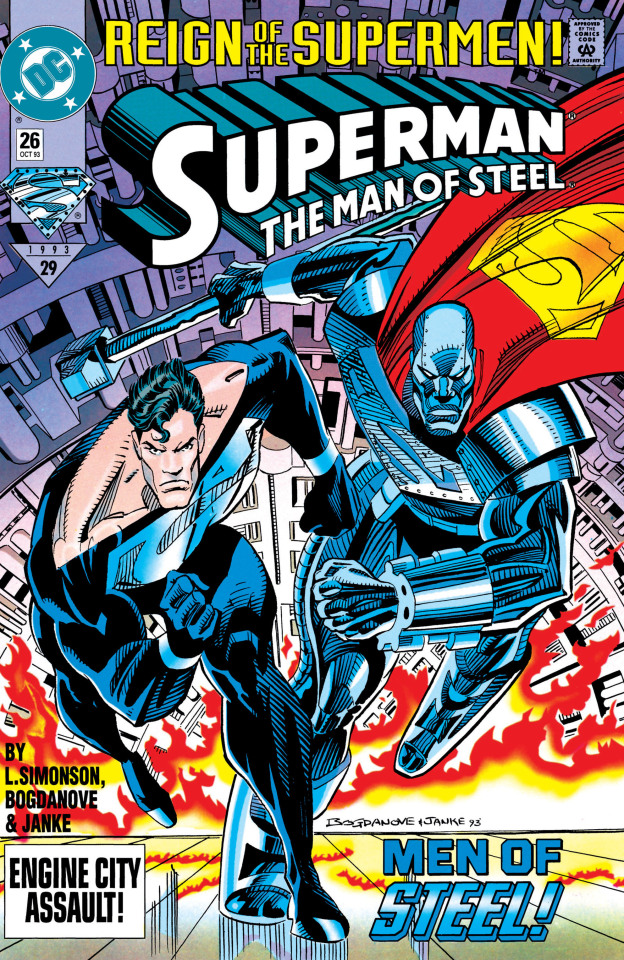
Superman: The Man of Steel #26 (October 1993)
REIGN OF THE SUPERMEN! In this issue: Steel vs. the Cyborg... or, if you prefer, John Henry vs. the Machine. The Man in Black and the Man of Steel are still exploring the Cyborg Superman’s ginormous Engine City (formerly Coast City) when they hear a massive rumble -- looks like someone put the keys in the ignition, which is bad news for everyone on Earth. See, the Cyborg’s plan was to put several of these engines across the planet to turn the Earth into a knock-off Death Star, but his lackey Mongul betrayed him and decided to start the first engine before time. As a result, the whole planet will spin out of orbit and break itself apart due to, uh, physics and stuff.
Our heroes bump into Mongul as he’s making his escape, and he decides to stick around a little while longer to beat their asses. The Man in Black decides to fight Mongul to allow Steel to go into the engine itself and hopefully turn it off before it destroys the planet. Now, Mongul might be a planet-killing bastard, but at least he’s considerate enough to give the Man in Black and Steel a little moment to themselves before they separate. Aw.

“It’s you! The guy who looks exactly like the steel mask I’ve been looking at!”
So, Steel goes into the engine, but the thing is so massive and complex that he doesn’t know how to even start turning it off. Luckily, he gets some unexpected tech assistance from the Cyborg (well, some chunks of metal animated by the Cyborg’s mind) and his complete inability to STFU.

Steel basically just lets the Cyborg keep talking about how the engine works as they fight, then uses that information to formulate a sophisticated plan to shut the machine down. That plan is called “jam the Cyborg and himself into the gears and make the whole thing explode”.

It works! The Cyborg is still alive and he still has a giant, kryptonite-powered fortress in his power, but at least the planet won’t crumble anymore, so that’s something. Anyway, let’s check on how the Man in Black’s been doing against Mongul...
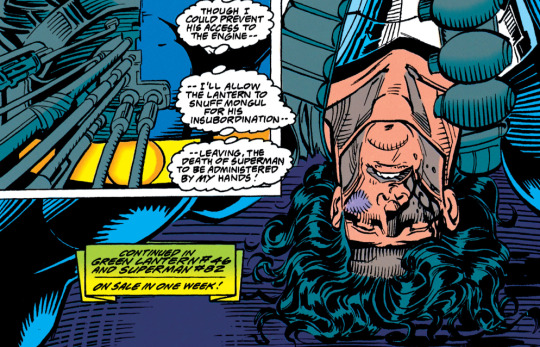
Uh-oh.
Character-Watch:
Superboy had his big character-defining moment a few weeks ago when he pushed himself to the limit to stop that missile, and now it’s Steel’s turn. If Superboy’s moment was about rising up to the occasion, Steel’s is more about using his engineer brain to outsmart the Cyborg. His best stories are the ones where he tackles impossible problems until he finally breaks them down (literally, with a hammer). What a cool character. Too bad he died in this issue and stuff.
Plotline-Watch:
Halfway through the issue we see Green Lantern Hal Jordan coming back to Earth from a mission in space and he’s like “And now to take a big sip of water and check on my beloved home town of Coast City...” Don Sparrow says: “Some rough news, to be sure, but Hal’s been a noble hero for so long, I know he’ll be able to handle the disappointment like the hero as he has been consistently been portrayed for all these decades…”
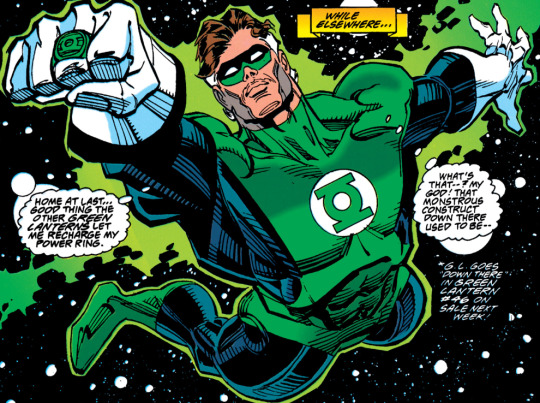
Don’t worry, we’ll see Hal go “down there” in Green Lantern #46 soon!
We also see Old Man Eradicator flying down on Engine City. It’s all coming together!
Supergirl, once again in her invisible form, tries to help the mostly powerless Man in Black against Mongul, but he showers her with a convenient oil pipe and takes her out of commission in two seconds. If I were the Man in Black, I’d ask for a refund on my Emergency Secret Weapon.

Jeb-Watch: Lois sees Jeb “Homewrecker” Friedman for the first time since he kissed her last month, and he tries to get her attention with a pretty shocking accusation: that she (*gasp*) loves Superman. Jeb expert Don Sparrow says: “I’m pretty famous for my hatred of Jeb in these pages, so I gotta love how hard Lois is ignoring him. Aside from dismissing his sexist jabs, his would-be haymaker about her loving Superman and not Clark is flat out ignored, and to my memory, never brought up again. Besides, if Clark is dead, as Jeb thinks he is, what would be wrong with Lois loving Superman? Stupid Jeb.” Suck it, Jeb.

And I’ll just let Don keep talking now. More after the jump!
Art-Watch (by @donsparrow):
This entire issue feels to me like it’s being backed with a guitar solo, and the cover is no exception: pure badassery, as Superman and the Man of Steel run from explosions like action movie stars. The opening splash on page one doubles down on the badassery, with Superman wielding an Image-comics-scale firearm (and while Jon Bogdanove has never shown an inability to draw feet, the convenient smoke hiding them does also remind me of Rob Liefeld, so more Image homage). [Max: I think he covered the feet so we can’t see Steel using his jet boots to look taller than Superman, again.]

Then ANOTHER splash follows on page 2-3 where we see the scale of our heroes relative to the giant engine structure.
Mongul’s bearhug looks pretty painful on page 6, and page 7 gives us yet another variation on the great poster from the Cyborg Superman’s first appearance. [Max: Those shots of Cyborg inside the machines always give me Superman III PTSD.] I love the mixture of low-tech and high tech that Bogdanove uses to show us the alien Engine City. Aside from wires and gears, we also get shapes that look very analog, like transistors and the like. Also the Cyborg being shown coming to life through his structures is a real visual playground for the art team, with some of his forms looking like himself, and others looking downright monstrous.

Did I think we’d get to see an oiled up Supergirl when I opened this issue? No, no I did not.
The beating Mongul lays on Superman is very painfully drawn, particularly that last left hook Superman takes. [Max: Why does this look so familiar? It could be that similar cover image with Bibbo punching Superman, but I have a feeling both things are homages to something else. Some Neal Adams thing maybe?]
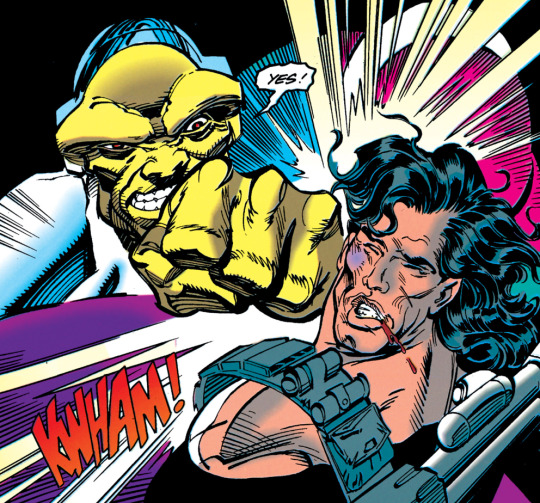
Mongul’s power level has always been something of a mystery to me. Alan Moore’s “For the Man Who Has Everything” put him on a par with Superman, right up there with Darkseid for power level. But then when Superman fought him in the gladiatorial games on Warworld, Superman didn’t have much trouble beating him, even though he had been out of range of a yellow sun for a very long time and was therefore, again, only using a fraction of his regular power.
The sequence of Steel hammering away at the Cyborg is well done, and appropriately reminiscent of The Mechanical Monsters, from the old Fleischer Superman cartoons (a well that Bogdanove rightly revisits a lot!)
STRAY OBSERVATIONS:
This issue serves as a precursor to the Man of Steel comics from the early 2000s, where John Henry Irons served as an unofficial partner to Superman in Superman: The Man of Steel when it was being written by Mark Schultz (one of the more readable Superman titles of the mostly awful Joe Kelly-Joe Casey era).
Mongul’s done a lot of lousy things over the years, but it was downright decent of him to just flat out stand there and wait for Superman and Steel to have their bro moment before attacking the very-weakened Superman. [Max: Great minds, Don.]
This issue reads very choppily, as a lot of the transitions are jarringly abrupt. From when Superman barely finishes his sentence when they come against Mongul, or later when we cut away from Jeb midsentence to the Cyborg, then jumping right to Steel in the engine room, it can be confusing as a reader. Anyone else notice this?
Looks like Bog has skipped right past the Clint Eastwood of last week, and is taking the Eradicator right into R. Lee Ermey territory.

It’s fitting that in what amounts to the final issue of this being a Steel comic (until his own later series) that they finally raise the John Henry story, as the inspiration for Steel’s name. In an industry with a reputation for underrepresenting people of colour, Simonson and Bogdanove’s Superman: the Man of Steel has consistently featured prominent African-American characters, and portrayed them with nuance and dignity rarely afforded in the mid-90s.
I would have liked to seen a little more acknowledgement from the Cyborg of just how much his plans are screwed up, but I suppose it’s all supposed to further demonstrate how insane he is. One thing after another, his plans fail (Superboy survives, saves Metropolis, Warworld conversion fails, SUPERMAN IS ALIVE, Mongul betrays him, Green Lantern is coming to help, etc). Now he’s saying “ah, it’s all cool, all that matters is my plan to kill Superman!” Except that he thought that Superman was dead when he hatched this whole plan! [Max: I guess they had to make it sound like there was still stuff on the line before the big climax... but yeah, that was weird. No one’s buying it, Hank.]
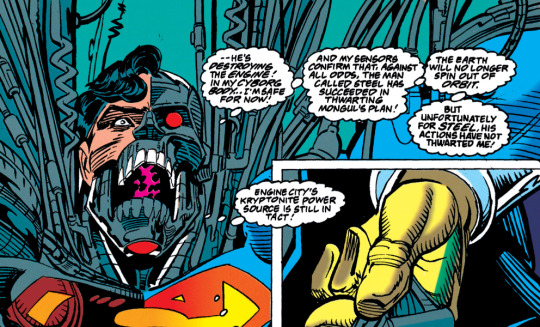
Aside from a few pages where they go ALL OUT (like the aforementioned Engine City spread), there’s a real dearth of backgrounds in this issue, with tons of figures on solid or blank backgrounds.
I’m glad we got a little update on Lois after Superman jetbooted away again, it was kind of her to assure them that this is indeed the real Clark who has returned. Still, that conversation could have been a lot more awkward than it was.
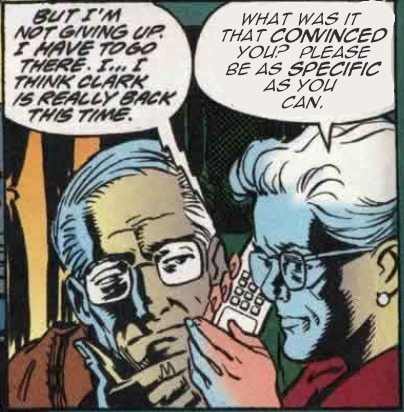
FOOLS! The Man in Black is an impostor! My money’s on Bibbo now.
#superman#louise simonson#jon bogdanove#dennis janke#steel#coast city#mongul#ma kent#pa kent#jeb friedman#hank henshaw#hal jordan#green lantern#supergirl#eradicator#old man eradicator#agh no i thought about superman iii goodbye sleep#reign of the supermen
9 notes
·
View notes
Text
は VS が Particles
(Posted by DestinyCall on Duolingo in response to the question. Posting here for my own future reference as I also often confuse the two.)
What you have been told isn't entirely wrong, but I think it misses the key purpose of these important particles and has caused you unnecessary confusion.
Unfortunately, Duolingo does a really poor job of explaining core grammar particles. And the roles of がand は are difficult to clearly understand from a bunch of random practice sentences without a proper foundation.
Let's start with the basics.
が is the subject marking particle. It marks the grammatical subject of the sentence. This is typically the actor or doer of the verb's action. Or in a descriptive or copular sentence, the subject will be the thing that is being described or compared.
ジョンが学校へ行きます。 (Jon ga gakkō e ikimasu.) "John goes to school."
In this sentence, ジョン is followed by が so we know that John is doing the action described by the verb 行きます "to go". And 学校 is marked by へ, the direction marking particle, so we know that he is going TO the school. The particles describe the grammatical relationship between the words. And が is one of the most important, since it defines the subject of the sentence.
However, you have probably noticed by now that a lot of sentences do not use が at all. Instead, they will frequently use は. This is because the Japanese language tends to prefer to drop the subject out of the sentence when it isn't absolutely necessary.
は is the topic marking particle. It marks the topic of the conversation as a whole - whatever you happen to be discussing at the time. In English, topics are rarely used. But in Japanese, they are a core part of the language. Rather than stating the subject of your sentence directly, in Japanese, you will bring up a topic and allow the listener to understand your intended meaning based on context. There is a lot of contextual information built into the Japanese language and how it works, so the same sentence can end up meaning very different things in different contexts. It can be a little tricky to work out when you are new to the language, but it gets easier with practice and experience.
Using the previous example sentence, this is a much more natural sounding version:
ジョンは学校へ行きます。 (Jon wa gakkō e ikimasu.) "As for John, (he) goes to school."
In this sentence, John is the topic. The actual subject of the sentence is left implied, but easy to guess based on the context provided by the inclusion of a topic.
Interestingly, you could even drop the topic and simply say:
学校へ行きます。
This sentence is a perfectly valid sentence in Japanese, even though the subject has gone missing entirely. In a normal conversation, it would be clear from context. As a stand-alone sentence, the natural interpretation would be "I go to school", but in the right context, it might actually mean "He goes to school." or "You go to school." or even "They go to school."
For example, let's give a little more context ...
ジョンとメアリーは学生です。学校へ行きます。 (Jon to mearī wa gakusei desu. Gakkō e ikimasu.) "Regarding John and Mary, (they) are students. (They) go to school."
Notice how ジョンとメアリー (John and Mary) are marked は. That means that the rest of the sentence and the following sentences are related to that topic.
There's no exact translation of the particle は, since there is no direct English equivalent for its function, but I will tend to translate it as "As for X" or "Speaking of X" or "Regarding X" when I am doing a DIRECT translation from Japanese to English. When I want to make a more natural-sounding English translation, I will usually remove the topic and reorganize the sentence to match normal English grammar. In Japanese, the topic heavily used as a way to introduce something you wish to talk about in greater detail. The topic itself is important to the conversation as a whole, but it is always what comes AFTER the topic that is new information. That's where your attention should be focused.
So what about が? Most of the time, where you would expect a subject to be provided in English, you will either see a topic OR nothing at all. But sometimes, you can't avoid stating the subject. Either because it is part of a grammar pattern that requires a stated subject or because the subject itself is very important and needs to be emphasized. Since が is rarely used, it draws extra attention to the subject when you choose to state it plainly, rather than leaving it implied.
One of the most common places that you will see this in early Japanese studies are when you are using the verbs of existence, ある and いる. Generally, when you talk about whether or not something exists, you will use が.
あそこに猫がいる。 (asoko ni neko ga imasu.) "There is a cat over there."/"A cat exists over there."
猫 is marked by �� because it is doing the verb's action. It is "existing" over there. It would sound rather strange to say it like this:
あそこに猫はいる。 (asoko ni neko ha imasu.) "As for the cat over there, (it) exists."
I mean ... why are you even bringing that up? Weird.
Topics are always shared information. Something that both you and your listener already know about. If it hasn't been discussed yet, new information must be introduced into the conversation first, usually with a shared topic or implied by contextual cues, or with a stated subject. So in order to use the cat as a topic, your listener must already know about it or at least be aware of its existence. Which sort of undermines the purpose of the whole sentence.
Now let's look at another example sentence:
象は鼻が長い。 (Zō wa hana ga nagai.) "Elephants have long noses."
Now look at how the grammatical particles mark this sentence. what do you see? In the naturalized English translation, the subject is "elephants." But is that true for the Japanese sentence?
Here's a hint. The word for "elephant" is 象 and the word for "nose" is 鼻.
That's right ... the grammatical subject is 鼻 which means that the subject is actually "nose". So what does this sentence really say in Japanese?
象は鼻が長い。 "As for elephants, (their) noses are long."
The structure is actually quite a bit different from what you might expect based on the original English translation. Due to the differences in sentence composition between English and Japanese, it is quite common to encounter natural English translations which deviate quite a bit from the Japanese sentence, both in terms of grammar and vocabulary.
Let's try another one:
ボブは猫が好きです。 (Bobu wa neko ga suki desu.) "Bob likes cats."
So .. what is the subject in this sentence? It's obviously not Bob.
Yep, it is 猫 (cat). In Japanese, fondness is expressed differently. Instead of using a verb to describe someone doing the action of liking something else, an adjective is used to describe the object of your affections as something that is liked or likeable. The person who is doing the liking is identified using a topic and the thing that is liked is the subject of the sentence.
ボブは猫が好きです。 "As for Bob, cats are liked."
I've only just touched the surface, regarding Japanese grammar and there's much more to say about the relationship between が and は, but I think that's probably enough for now.
If you'd like to know more about how to use these particles and how they differ, I recommend reading this article:
http://nihonshock.com/2010/02/particles-the-difference-between-wa-and-ga/
Personally, I think the most important thing is to recognize that が always marks the subject and that the topic is NOT the same as the implied subject. The rest will become clearer as you read more Japanese and get better at deciphering what is actually being said in the Japanese sentences.
Also ... Don't trust too deeply in naturalized English translations when trying to understand new grammar. They can be quite misleading. It is always better to trust the particles instead. The particles will tell you what is really going on.
0 notes